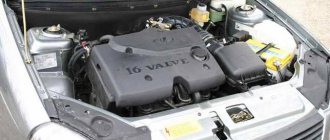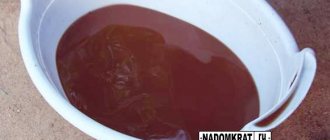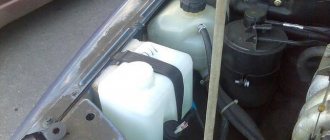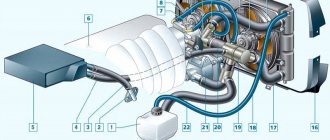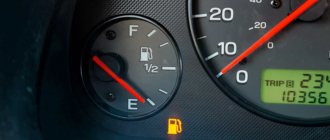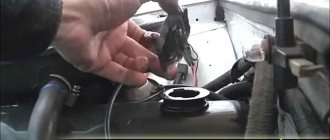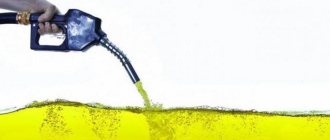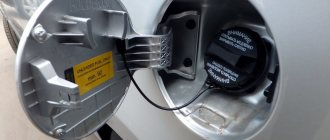How many kilograms are in a liter of antifreeze?
Mass is a characteristic of a body, which is a measure of gravitational interaction with other bodies.
Volume is a quantitative characteristic of the space occupied by a body, structure or substance.
Density is a physical quantity defined as the ratio of body mass to body volume.
The relationship between liters and kilograms of antifreeze is determined by a simple mathematical formula:
V – volume; m – mass; p – density.
In the calculation, the density of antifreeze was taken = 1112 kg/m3.
The density of antifreeze can vary depending on temperature and pressure. You can find the exact density of antifreeze in reference books.
See also the universal program for converting liters to kg for any substance depending on its density.
If you need to convert m3 to tons, then see the program for converting tons to m3.
If you need to convert kg to m3, then see the program for converting kg to m3.
Question: How many kg are in a liter of antifreeze?
Answer: 1 kg of antifreeze is equal to 0.899 liters.
Question: How many liters are in a kilogram of antifreeze?
Answer: 1 liter of antifreeze is equal to 1.112 kilograms (kg).
You can quickly solve this simple mathematical operation using our online program. To do this, enter the initial value in the appropriate field and click the button.
This page presents the simplest program for converting kilograms of antifreeze into liters. With this online calculator you can convert liters of antifreeze to kg and back in one click.
It's no secret that the most important thing in a car is the engine. Its efficient operation depends not only on high-quality fuel and an appropriate lubrication system, but also on the cooling system. And throughout the history of the car, designers have addressed the issue of increasing the efficiency of the car's engine cooling system with the help of.
Why use oil conversion in kg?
Our online calculator for converting kg of oil to liters will make it possible to find out the weight of one liter or more of motor oil, and will also allow you to recalculate the weight in kilograms or tons of any other type of oil, fuel and other fuels and lubricants. Or, on the contrary, understand how many liters of raw materials should be at a certain weight.
Such a transformation may be needed not only for reporting in organizations involved in fuel and lubricants or transport companies, but also for ordinary car owners. How?
As an additional indicator of the need for an oil change. After all, the weight of one liter will change by 4 - 7% during wear and tear over 1-2 years. And if you focus on the average density, then by weighing still fresh oil you can determine its quality. Low-quality motor oil may contain harmful additives, due to which it will have increased density and, accordingly, more weight. Or vice versa, due to an insufficient amount of additives for a particular type of oil, the mass will be less than it should be according to the characteristics specified by the manufacturer.
And also, knowing the fact that the volume of oil increases when heated, some suppliers, when filling cans on the packaging line, heat the lubricant and pour it according to the volume, rather than weighing it. As a result, the canister of oil on the counter will stand compressed and several grams lighter, because, in fact, it will not be topped up. An individual buyer will not notice a shortage of a few milliliters, but on the overall scale of production, the difference is significant. Therefore, by weighing such oil and using a conversion calculator, it will be possible to identify such a deficiency.
History of coolants (antifreeze)
The first engines of the 19th century were air-cooled.
Around 1900, water-cooled engines appeared.
Since the 1930s, pumps and thermostats have been used for the first time to increase cooling efficiency.
Early coolants or antifreezes were: 1. Saline solutions of sodium and calcium chlorides. 2. Solutions of glycerin, sugar and honey. 3. Methyl and ethyl alcohols.
Since 1930, ethylene glycol has been used for the first time.
Since 1939, special anti-corrosion packages have been used.
Why is a car engine cooling system necessary?
Combustion of the fuel mixture in the engine occurs at temperatures of 2100–2300°C. At this temperature, without forced cooling, engine parts would heat up to a temperature significantly higher than the ignition temperature of the oil. In addition to oil combustion, when the engine overheats, the frictional forces and wear of parts increase, thermal clearances decrease, oil coking and carbon deposits occur, and the filling of the cylinders of carburetor engines with the combustible mixture, and of diesel engines with purified air, worsens.
At the same time, excessive heat removal leads to engine overcooling and a change in the viscosity properties of the oil, which leads to increased wear of parts, a decrease in engine power and efficiency. The ideal thermal regime of the engine is 85-95°C, regardless of its load and ambient temperature.
What to do?
• Use antifreeze that meets your vehicle manufacturer's specifications.
• If you bought a car and don’t know what was poured into it and when, it is better to replace all technical fluids (oil, antifreeze, brake fluid).
• To add, use the same brand of antifreeze. Different manufacturers may use incompatible additive packages.
• Whatever the perfect antifreeze, it is necessary to regularly monitor its level according to the marks in the expansion tank and the concentration using a glycometer, due to the formation of condensation, possible leaks and evaporation, and also replace it within the time specified in the instructions for the car by the manufacturer .
Antifreeze replacement time
The exact service life of this consumable cannot be given. It all depends on the quantity and quality of additives, manufacturer, and composition of the coolant. Currently, in domestic markets you can find antifreezes that are made on the basis of carboxylate or silicate. For example, coolant that contains silicate will need to be replaced after three years of car operation. Refrigerants that are made on a carboxylate basis can last five years. It is also advisable to familiarize yourself with the recommendations of the manufacturer of a specific car brand.
How to dilute antifreeze concentrate?
All information is on the label. If information is missing or unclear, remember the following:
• Never pour concentrate pure without dilution. You will receive antifreeze with a freezing point of -13°C and a strong corrosive effect.
• It is not recommended to use antifreeze with an ethylene glycol content of more than 67% and less than 30%. Common dilution: 33% ethylene glycol and 67% water (1:2) will give you -17°C. 50% ethylene glycol and 50% water (1:1) will give you -36°C. 55% ethylene glycol and 45% water (1 ,2:0.8) will provide –40°C. 65% ethylene glycol and 35% water (2:1) will provide –65°C.
ATTENTION!
Ethylene glycol is a strong poison. If ingested, it causes severe intoxication, damaging the central nervous system and kidneys. The lethal dose for an adult is 100 ml. The problem is the sweet taste, which can attract your children and pets. We do not have statistics on ethylene glycol poisoning for Russia, but in the USA, where this problem is taken under separate control, over a thousand cases of fatal poisoning are reported annually. Avoid contact of ethylene glycol with skin. We strongly recommend that you store antifreeze, like all technical fluids, out of reach. Spilled antifreeze should be immediately removed with a rag or sand and then disposed of. Getting ethylene glycol into soil or water also poses a threat to plants and fish.
To ensure environmental safety and eliminate cases of poisoning, propylene glycol-based antifreezes are used. Propylene glycol has long been used in the production of food, medicines and perfumes. In heating systems for residential premises and food production, according to European standards, only propylene glycol is allowed to be used. Most municipal transport in Europe has switched to propylene glycol. Propylene glycol, unlike ethylene glycol, is less aggressive to metals and has greater thermal conductivity.
A review of antifreeze (coolants) was prepared by Pavel SHULYAKO.
Antifreeze for heating systems (coolant)
Selection by parameters
Due to sharp fluctuations in the exchange rate of the euro and dollar, prices may differ from the prices on the website!
THIS IS INTERESTING: How to properly light a car with a dead battery
list | net
Sort by: Newness Name Price
Positions: 1 to 10 (out of 10)
Heating in most country houses and cottages is represented by independent heating systems operating on liquid coolant. Depending on the design of heating systems, specialists determine the rules for their operation and maintenance.
Liquids for heating systems are divided into two large groups:
- antifreeze,
- liquid for flushing the heating system.
The most common type of coolant is water, which has a high heat capacity and can maintain temperature for a long time. Meanwhile, water contains dissolved oxygen, which is released over time and contributes to metal corrosion, which reduces the value of this liquid when used in heating systems.
Most modern heating systems provide the ability to replace water with a more efficient coolant. The characteristics of the selected liquid will determine the serviceability and efficiency of the entire system.
Antifreeze: advantages and disadvantages
Using antifreeze in your home's heating system provides a number of advantages over using regular water:
- does not freeze at low temperatures;
- does not cause corrosive processes;
- eliminates scale formation.
Antifreeze for heating systems has a number of characteristics that may require upgrading the system and a slightly different approach to its operation:
- the heat capacity of antifreeze is 15% lower than that of water, so heat transfer will occur more slowly;
- higher viscosity requires the use of a more powerful circulation pump;
- a more significant expansion of antifreeze when heated requires the presence of an expansion tank and larger radiators in the system;
- antifreeze is more fluid, so all connections in the system must be carefully sealed;
- When using antifreeze that contains ethylene glycol, you should remember its toxicity and use it only in single-circuit systems.
How many kilograms are in a liter of antifreeze?
Mass is a characteristic of a body, which is a measure of gravitational interaction with other bodies.
Volume is a quantitative characteristic of the space occupied by a body, structure or substance.
Density is a physical quantity defined as the ratio of body mass to body volume.
The relationship between liters and kilograms of antifreeze is determined by a simple mathematical formula:
V—volume; m—mass; p—density.
In the calculation, the density of antifreeze was taken = 1112 kg/m3.
The density of antifreeze can vary depending on temperature and pressure. You can find the exact density of antifreeze in reference books.
See also the universal program for converting liters to kg for any substance depending on its density.
If you need to convert m3 to tons, then see the program for converting tons to m3.
If you need to convert kg to m3, then see the program for converting kg to m3.
Question: How many kg are in a liter of antifreeze?
Answer: 1 kg of antifreeze is equal to 0.899 liters.
Question: How many liters are in a kilogram of antifreeze?
Answer: 1 liter of antifreeze is equal to 1.112 kilograms (kg).
You can quickly solve this simple mathematical operation using our online program. To do this, enter the initial value in the appropriate field and click the button.
This page presents the simplest program for converting kilograms of antifreeze into liters. With this online calculator you can convert liters of antifreeze to kg and back in one click.
Personally, I believe that liquid engine cooling is much better and more progressive than air cooling (the facts show this, now 99.5% of cars are equipped with it). But antifreeze or antifreeze do not last forever and they simply need to be changed after a certain interval (usually 3 - 4 years). And then you may have a question, how many liters of this liquid are in the cooling system? And you know what (while I was writing this article), another question arose - why exactly such a volume, as they say, no more and no less? In general, the article and, as usual, the video at the end will be interesting, so read and watch...
How to replace antifreeze on a VAZ 2107?
If you are in doubt about the state of antifreeze or antifreeze in your car’s cooling system, then know that the freezing temperature can be determined by the density of the coolant. Here we will tell you how to do this if your antifreeze or antifreeze is based on ethylene glycol. This is the majority of antifreezes and antifreezes today. More details in the article “Types of antifreeze and antifreeze.” So, different ratios of ethylene glycol and water accordingly form different densities. So, in particular, 1 liter of water weighs 1 kg, but 1 liter of ethylene glycol is already 1.120 kg, so from determining the weight in 1 liter, that is, in fact, from determining the density, one can conclude about the content of ethylene glycol in water and, as a result, summarize the freezing point for a given antifreeze or antifreeze. The density of antifreeze and antifreeze is measured with a hydrometer or other similar, easy-to-use device. As a rule, this is an ordinary float that sinks to different depths depending on density. Indeed, at different densities, the Archimedes force will also be different; the Archimedes force is a force equal to the mass of the displaced solution by the volume of the body immersed in it.
Table of the relationship between density and freezing point of antifreeze or antifreeze
Why change antifreeze at all?
The thing is that antifreeze or antifreeze itself (this is a Russian, or rather a Soviet invention) becomes unusable over time, and if you don’t want your radiators, pipes or hoses to corrode, you must change them!
What and how does it corrode? Just a few words for understanding - look, coolant consists of three main components:
- Ethylene glycol or propylene glycol (less toxic and used in the G13 generation). These are simple dihydric alcohols, very active and, with prolonged exposure, can destroy metals, rubber, etc.
- Distilled water
- Additives. They are needed mainly only to neutralize the negative effects of ethylene glycol and propylene glycol (to put it in simple words, they prevent them from corroding everything and everyone)
- Well, the last thing is dye
Well, actually, why do you need to change? YES, just after 3 - 5 years the additives wear out and stop working, that is, the liquid that is poured inside becomes VERY active.
How many liters are in the system?
Well, now the most interesting thing is how much antifreeze is needed. I will provide a breakdown of several popular brands and models:
VAZ. In older versions (2101 - 2107) it was about 8.6 liters . Fresh front-wheel drive versions (PRIORA, KALINA, GRANT 2109 - 2115) - 7.8 liters
RENAULT. In particular LOGAN (SANDERO) – 5.5 – 6 l.
KIA ( Hyundai) . In particular, let's talk about RIO (Solaris). It all depends on the engine size: 1.4 – 5.5 liters; 1.6 – 5.8l
Daewoo . In particular NEXIA. Engine 1.5 (8 valves) – 6.2 liters, 1.5-1.6 (16 valves) – 6.7 liters.
If we take the arithmetic average for various brands and brands, engines with a volume of 1.4-1.6, it turns out from 5.5 to 8 liters . In any case, you need to buy two 5 liter canisters. There will still be left for topping up (and you’ll also flush the system a little)
BUT this is what interested me, and I think you will too. Why exactly so much antifreeze or antifreeze, that is, say 7 liters, and not 3 or 10 liters? Why such a volume? And there is a completely reasonable explanation for this.
Subtleties of cooling
To understand how much antifreeze is needed in the cooling system, an engineer needs to calculate many different parameters. Several problems are solved:
- To prevent the engine from overheating, the coolant does not boil over the entire load range (both at idle and at maximum speed). Effective removal of thermal energy from the motor (so that it does not jam)
- It is necessary for the liquid to warm up relatively quickly; it is important for winter so that you do not freeze in the car. Also, various components in the car are heated for more stable operation (for example, the throttle)
Therefore, there should be neither too much nor too little antifreeze in the cooling system, but enough.
In order to calculate correctly, we first need to take such an important parameter as the efficiency of the internal combustion engine , and we will understand that this is not such a large percentage, only 20 - 25%
And the rest goes to mechanical and thermal losses (they are what we are interested in).
Approximately 30% of energy is lost to heating. That's a lot!
We will count them based on the engine power. It is usually indicated at peak (that is, at maximum speed, say 4000 - 6000, different for different manufacturers). Often you just see power of 100 - 120 - 150 - 200, etc. Horse power
For convenience, let’s take a 100 hp engine. and convert the power to KILOWATTS. For this, 100/1.36 = 73.55 kW (1 kW = 1.36 hp). Once again, you need to understand that this power at maximum speed
As a result, 73.55 X 30% (this is exactly how much is spent on heat losses) = 22.065 kW, rounded to 22.1
Just think about it: 22.1 kW is spent on heating, and it just needs to go somewhere. By the way, from this indicator you can safely subtract about 9 kW (40%) that fly out into the chimney with exhaust gases.
We count further. For example, let’s take that our motor is made of aluminum and weighs 100 kg. In order to heat aluminum, we need to apply 3.9 X 10 5 = 390,000 J per kilogram. If we convert all this into kW, we get 0.1 kW per kg , multiply by 100 = 10
Thus, to heat a motor weighing 100 kg, we need 10 kW of thermal energy.
A standard car radiator dissipates about 2 kW of heat in a quiet state, and about 3-4 with airflow. At extremely low temperatures, dissipation increases. It is worth noting that the car also has a heater radiator (pipe pipes, etc.), in a quiet state it dissipates about 0.5 kW; when blown, it can provide 1 to 2 kW of heat into the cabin.
So what's the bottom line? 22.1 kW (maximum heat). We subtract 10 kW to warm up the engine, 9 kW goes into the exhaust pipe, about 2 kW for the main radiator + 0.5 kW for the heater radiator. 10 + 9 + 2 + 0.5 = 21.5 kW.
We need to remove about 0.6 kW more, we also need to use the radiator, because without liquid it will not work.
Instructions for replacing antifreeze
- Purchase . It’s worth choosing a high-quality, suitable antifreeze (indications and characteristics should be looked at in the instructions for the car, checking the manufacturer’s label).
- Preparation . You need to start the car and let it run for 10 minutes without load. After this, set the heater (stove) to the maximum value. After some time, turn off the engine.
- Draining the system . Drain the used fluid from the entire cooling system. For convenience, it is better to park the car so that the front part is slightly lower than the rear. This will allow the antifreeze to flow more intensively. Then you should turn the cap on the expansion tank to relieve pressure in the system (in some car models you need to turn the cap on the radiator, sometimes you need to turn both of them). After the liquid does not pressurize the system, it will quickly cool down, which will prevent injury or burns. When you can touch the plug with your hand, you need to unscrew it completely. Then you should also carefully open the radiator drain valve, having previously prepared containers in which you can later transport the used coolant to the disposal site.
- Flushing. After all the antifreeze has been drained, it is necessary to flush the cooling system. This procedure is carried out only when switching to another brand of coolant or in the case when preventive maintenance is performed. Distilled water removes scale well and washes away corrosion deposits. If the system needs more thorough cleaning, then special flushes for cooling systems should be used. After deciding on the means by which this operation will be performed, all taps should be closed (it is advisable to carry out manipulations with a cold engine to avoid burns). Then pour the flushing agent into the expansion tank, tighten all the plugs and start the engine for 10–15 minutes. Then drain the rinse and repeat all steps 2-3 times.
- Filling the system . After cleaning the system, it is advisable to pour only new antifreeze that was purchased earlier. Coolant should be poured into the expansion tank, preferably without stopping, so that air does not enter the system along with the antifreeze. But there are car models where the coolant is poured into the radiator neck. You should perform these steps very carefully and not confuse the expansion tank with the washer fluid reservoir, since they are located mostly next to each other and are very similar to each other. It is advisable to fill antifreeze to the maximum value, because the liquid will spread throughout the entire system over time.
- Air release . When filling of the cooler is completed, you need to bleed the air from the system. This is done by unscrewing the screw located on the cylinder block. When the first drops of antifreeze appear (this will mean that all the air has escaped), the screw is tightened until it stops. After this procedure, you should start the car engine again and let the engine run for several minutes, slightly increasing and decreasing the speed. After this, you need to turn off the engine, wait a while and check the coolant level in the expansion tank. If necessary, add antifreeze to the normal level. Also, after replacing the antifreeze, it is worth checking the cooling system daily for a week, since it is during this period of time that hidden problems in the system that were previously invisible can be identified.
